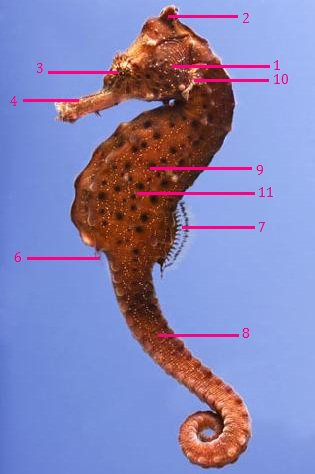Adaptation
Seahorses are amazing creatures and are well suited for their
environment. They have numerous body parts which give them the
ability to live in the ocean, hide from prey, as well as other
vital parts that give them the chance to survive in the vast
ocean.
 Pectoral Fin:
1
Pectoral Fin:
1
The pectoral fins are located on
either side of a seahorse's body, right below the gill
opening. The seahorse flaps the fins back and forth in
order to move, steer, and for stability.
Coronet: 2
The coronet is a bony projection
found on the top of the seahorses head. Depending on how
thick and how high the coronet is, it can help identify
the species of seahorse. It is believed that coronets
are similar to human fingerprints, and each seahorse has
a unique coronet.
Turreted Eyes: 3
Seahorses have two eyes which have
the ability to move in different directions. Their
magnificent eyes allows the seahorse to find more food
as well as watch out for predators.
Snout: 4
The long snout of a seahorse is an
adaption used for foraging for food. The snout is
similar to a straw and sucks up the seahorses food, such
as zooplankton. Because of their snout is so long, only
a small turn of the head is necessary to reach prey
faster. With this ability seahorses can get more food.
Brood Pouch: 5
The brood pouch is only found on
the male seahorse. It is located underneath the anal
fin, and is used to incubate the eggs from a female
seahorse.
Anal Fin: 6
The anal fin is found at the body
of a seahorse's abdomen. This fin helps stabilize
the seahorse. In males, scientist believe it may assist
in the reproduction process.
Dorsal Fin: 7
This fin is located along the
midline of the seahorses back. Since the body of a
seahorse is vertical, the fin extends directly behind
the body. Seahorses aren't very fast swimmer, so the
dorsal fin powers through waves that
pass along it.
Prehensile Tail: 8
Seahorses lack a tail fin so they
are dependent on on their prehensile tail. Prehensile
meaning it has the ability to hold on to rocks, corals
or other objects and allows the seahorse to be anchored
in one position. Seahorses use their tails in a number
of different ways, such as in their mating rituals.
Gas Bladder: 9
The swim bladder, an internal
gas-filled organ, found in seahorse allows the seahorse
to control its ability to move up and down. This is a
great adaption so the seahorse does not waste a lot of energy swimming.
Gills: 10
Gills are the respiratory organ
found in seahorses. Gills extract dissolved oxygen from
the water, and then excrete carbon dioxide back into the
water. Gills are adaptations for the seahorse because
create more surface area . More surface area means more
oxygen and less waste.
Protective Plates: 11
Seahorses have bony plates which
are located under their skin, much like a suit of amour.
These plates are an adaption ,allowing protection for the seahorse against
predators.
Camouflage:
Seahorses also have the ability to
change colors. They can change colors for multiple
reasons, such as during their court dance with a mate or
possibly to hide from a predator. With the seahorse's
ability to camouflage, it makes hiding from a predator
much easier. This adaption is a great survival tool.
Continue to Nutrition